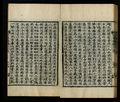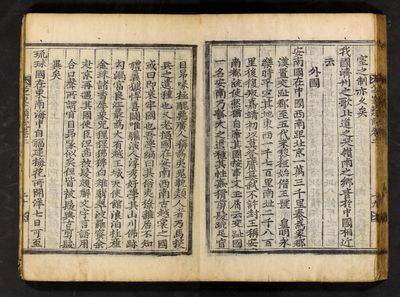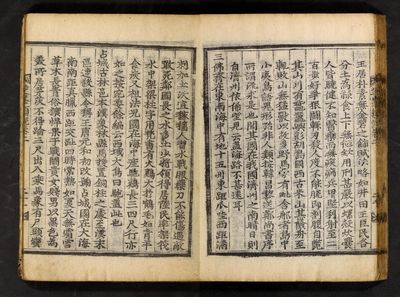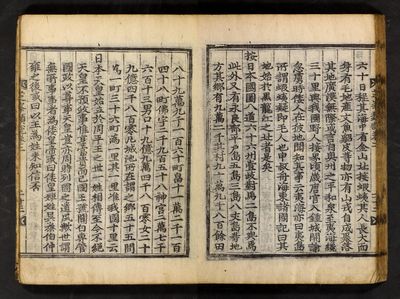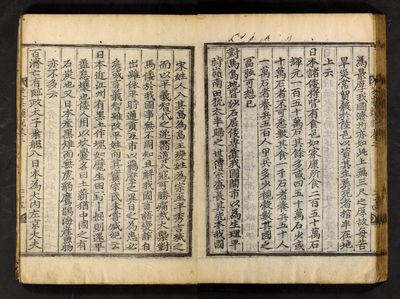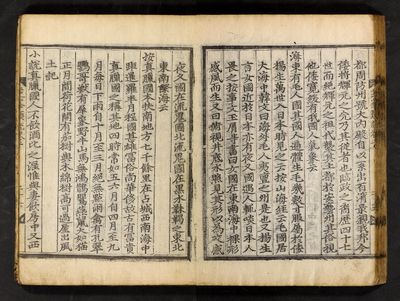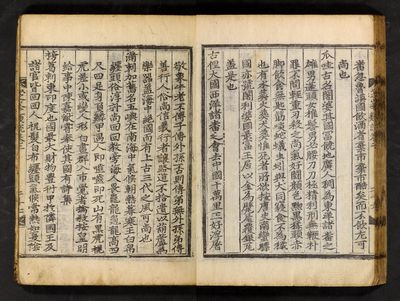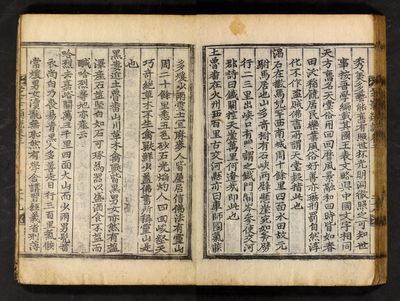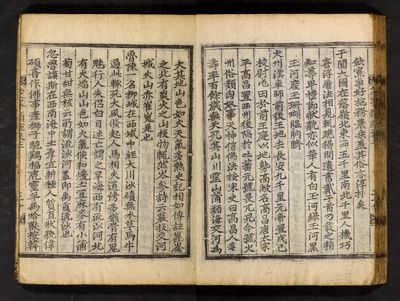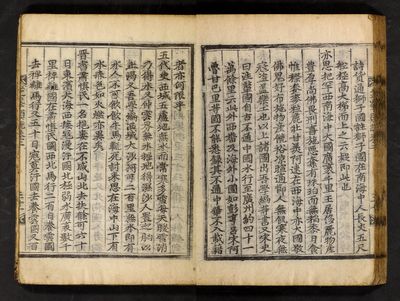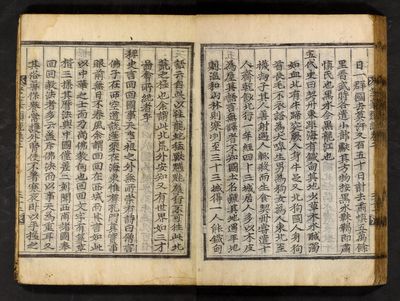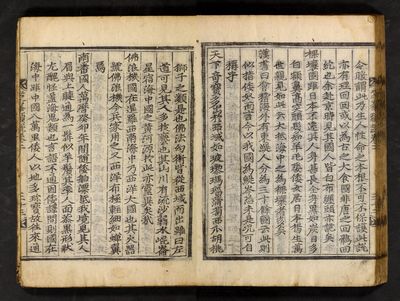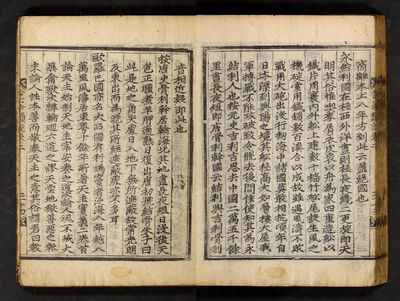"(Translation) 李睟光 外國"의 두 판 사이의 차이
장서각위키
| (사용자 6명의 중간 판 16개는 보이지 않습니다) | |||
| 3번째 줄: | 3번째 줄: | ||
|English = | |English = | ||
|Chinese = 芝峯類說 | |Chinese = 芝峯類說 | ||
| − | |Korean = 지봉유설(''Jibongyuseol'') | + | |Korean = [http://kostma.korea.ac.kr/viewer/viewerDes?uci=RIKS+CRMA+KSM-WZ.1614.0000-20090713.AS_BC_269&bookNum=&pageNum= 지봉유설(''Jibongyuseol'')] |
|Genre = [[Literati Writings]] | |Genre = [[Literati Writings]] | ||
|Type = | |Type = | ||
| 22번째 줄: | 22번째 줄: | ||
=='''Introduction'''== | =='''Introduction'''== | ||
| + | |||
| + | 自賣 was a prevalent method for the impoverished commoners to obtain subsistence in the extreme situation of famine during the late Choson period. This was called 口活’ | ||
| + | |||
| + | 한성부 향도꾼은 동내 주민 중심의 인적 구성을 벗어나 이웃 동내, 나아가 한성부 전체를 지역적 기반으로 하는 대형 조직으로 변모하였다 했다. 또한 노비의 입계를 허락하지 않는 가문은 계원들 다수가 그 집에 쳐들어가 쌍욕을 해대는가 하면 그 집 처녀를 보쌈을 해와 형제들끼리 나누어 가질 정도였다. 이같은 무리한 행위에도 불구하도 계원의 세력이 너무나 강해 항의조차 못할 정도였다. 향도계 계원들의 숫자는 많은 경우 수 백명에 달했고 적은 계일지라도 100 여명에 이르렀다. | ||
| + | |||
| + | 첫째, 그들의 상전 등 주위 양반들과 경제적 이해관계가 직접적이지 않았기 때문이었다. 주의 상전이나 양반들의 논밭을 경작하는 노비, 또는 하층민이라면 감히 토지소유주의 이해에 반하는 행위를 하지 못했을 것이다. 둘째, 익명성이 보장되고 회합이 용이한 도회지에서 활동했다는 점이다. 17세기 중엽 서울은 인구가 많을 뿐 아니라 유동 인구, 특히 도망 노비, 소작인들이 대거 이동함으로써 향도계원의 불법 혹은 도덕적 비난으로부터 일정부분 익명성을 보장받을 수 있었던 것이다. | ||
| + | |||
| + | connection with 중인. | ||
=='''Original Script'''== | =='''Original Script'''== | ||
| 27번째 줄: | 35번째 줄: | ||
{|class="wikitable" style="width:100%; background-color:#ffffff;" | {|class="wikitable" style="width:100%; background-color:#ffffff;" | ||
| − | !style="width:25%;"|Image || style="width: | + | !style="width:25%;"|Image || style="width:75%;"|Text |
|- | |- | ||
| [[File:지봉유설권2외국1.jpg |border|지봉유설권2외국1|400px]] | | [[File:지봉유설권2외국1.jpg |border|지봉유설권2외국1|400px]] | ||
| 35번째 줄: | 43번째 줄: | ||
2. 琉球國在東南海中。自福建梅花所開洋。七日可至。" | 2. 琉球國在東南海中。自福建梅花所開洋。七日可至。" | ||
| − | + | ||
| − | |||
|- | |- | ||
| [[File:지봉유설권2외국2.jpg |border|지봉유설권2외국2|400px]] | | [[File:지봉유설권2외국2.jpg |border|지봉유설권2외국2|400px]] | ||
| 45번째 줄: | 52번째 줄: | ||
4. 占城古林邑。本漢象林縣。馬援置銅柱之處。至漢末。區連殺縣令稱王。唐元和初。改號占城國。在大海南。南距眞臘。西距交趾。四時常熱如夏天。無霜雪。草木長靑。俗獷悍。果于戰鬪。貴女賤男。以黑色爲美。所居茅茨。不得踰三尺。出入乘馬象。有尸頭蠻" | 4. 占城古林邑。本漢象林縣。馬援置銅柱之處。至漢末。區連殺縣令稱王。唐元和初。改號占城國。在大海南。南距眞臘。西距交趾。四時常熱如夏天。無霜雪。草木長靑。俗獷悍。果于戰鬪。貴女賤男。以黑色爲美。所居茅茨。不得踰三尺。出入乘馬象。有尸頭蠻" | ||
| − | + | ||
| − | |||
|- | |- | ||
| [[File:지봉유설권2외국3.jpg |border|지봉유설권2외국3|400px]] | | [[File:지봉유설권2외국3.jpg |border|지봉유설권2외국3|400px]] | ||
| 57번째 줄: | 63번째 줄: | ||
7. 日本一州爲一國。而陸奧州最大。管五十四郡。東西" | 7. 日本一州爲一國。而陸奧州最大。管五十四郡。東西" | ||
| − | + | ||
| − | |||
|- | |- | ||
| [[File:지봉유설권2외국4.jpg |border|지봉유설권2외국4|400px]] | | [[File:지봉유설권2외국4.jpg |border|지봉유설권2외국4|400px]] | ||
| 67번째 줄: | 72번째 줄: | ||
9. 日本天皇。始立於周平王之世。一姓相傳。至今不絶。天皇不預政事。惟享富貴而已。國王號關白。專管國政。以尊事天皇。豈亦周時列國之遺風歟。世謂無所事事者。爲倭皇帝。或曰倭皇姬姓。吳泰伯仲雍之後。或曰以王爲姓。未知信否。" | 9. 日本天皇。始立於周平王之世。一姓相傳。至今不絶。天皇不預政事。惟享富貴而已。國王號關白。專管國政。以尊事天皇。豈亦周時列國之遺風歟。世謂無所事事者。爲倭皇帝。或曰倭皇姬姓。吳泰伯仲雍之後。或曰以王爲姓。未知信否。" | ||
| − | + | ||
| − | |||
|- | |- | ||
| [[File:지봉유설권2외국5.jpg |border|지봉유설권2외국5|400px]] | | [[File:지봉유설권2외국5.jpg |border|지봉유설권2외국5|400px]] | ||
| 78번째 줄: | 82번째 줄: | ||
12. 日本地暖無冰雪。而其北陸道甚寒。每冬雪深數丈。且海島皆石山戴土。故倭人專以土淺深爲饒瘠。若土淺一尺。則五穀不熟。其深七尺以上至一丈" | 12. 日本地暖無冰雪。而其北陸道甚寒。每冬雪深數丈。且海島皆石山戴土。故倭人專以土淺深爲饒瘠。若土淺一尺。則五穀不熟。其深七尺以上至一丈" | ||
| − | + | ||
| − | |||
|- | |- | ||
| [[File:지봉유설권2외국6.jpg |border|지봉유설권2외국6|400px]] | | [[File:지봉유설권2외국6.jpg |border|지봉유설권2외국6|400px]] | ||
| 92번째 줄: | 95번째 줄: | ||
16 . 百濟亡。有臨政太子乘船入日本。爲大內左京大夫。" | 16 . 百濟亡。有臨政太子乘船入日本。爲大內左京大夫。" | ||
| − | + | ||
| − | |||
|- | |- | ||
| [[File:지봉유설권2외국7.jpg |border|지봉유설권2외국7|400px]] | | [[File:지봉유설권2외국7.jpg |border|지봉유설권2외국7|400px]] | ||
| 104번째 줄: | 106번째 줄: | ||
19. 小說。眞臘國人。不飮酒比之淫。惟與妻飮房中。又西" | 19. 小說。眞臘國人。不飮酒比之淫。惟與妻飮房中。又西" | ||
| − | + | ||
| − | |||
|- | |- | ||
| [[File:지봉유설권2외국8.jpg |border|지봉유설권2외국8|400px]] | | [[File:지봉유설권2외국8.jpg |border|지봉유설권2외국8|400px]] | ||
| 118번째 줄: | 119번째 줄: | ||
23. 榜葛剌。東印度也。國最大。財物豐衍。甲於隣國。王及諸官。皆回回人。祝髮白布纏頭。氣候常熱如夏。陰" | 23. 榜葛剌。東印度也。國最大。財物豐衍。甲於隣國。王及諸官。皆回回人。祝髮白布纏頭。氣候常熱如夏。陰" | ||
| − | + | ||
| − | |||
|- | |- | ||
| [[File:지봉유설권2외국9.jpg |border|지봉유설권2외국9|400px]] | | [[File:지봉유설권2외국9.jpg |border|지봉유설권2외국9|400px]] | ||
| 130번째 줄: | 130번째 줄: | ||
26. 撒馬兒罕。漢罽賓也。去嘉峪關萬里。東西相距千里。風景偉麗。土田膏腴。頗類中原。西南番賈多聚於此。俗尚回回敎。有拜天屋。靑石雕鏤極精巧。人物" | 26. 撒馬兒罕。漢罽賓也。去嘉峪關萬里。東西相距千里。風景偉麗。土田膏腴。頗類中原。西南番賈多聚於此。俗尚回回敎。有拜天屋。靑石雕鏤極精巧。人物" | ||
| − | + | ||
| − | |||
|- | |- | ||
| [[File:지봉유설권2외국10.jpg |border|지봉유설권2외국10|400px]] | | [[File:지봉유설권2외국10.jpg |border|지봉유설권2외국10|400px]] | ||
| 146번째 줄: | 145번째 줄: | ||
31. 哈烈。去嘉峪關萬三千里。四面大山而少雨。男髡首。衣尚白。乃喪易靑黑。人多善走。日行三百里。氣候常煖。男女瀆亂無恥。然有學舍。講習經義。省刑薄" | 31. 哈烈。去嘉峪關萬三千里。四面大山而少雨。男髡首。衣尚白。乃喪易靑黑。人多善走。日行三百里。氣候常煖。男女瀆亂無恥。然有學舍。講習經義。省刑薄" | ||
| − | + | ||
| − | |||
|- | |- | ||
| [[File:지봉유설권2외국11.jpg |border|지봉유설권2외국11|400px]] | | [[File:지봉유설권2외국11.jpg |border|지봉유설권2외국11|400px]] | ||
| 160번째 줄: | 158번째 줄: | ||
35. 忽魯謨斯。在西南海中。土厚宜耕種。人質直。狀貌偉碩。喜作佛事。産獅子駞鷄福鹿靈羊馬哈獸。按韓" | 35. 忽魯謨斯。在西南海中。土厚宜耕種。人質直。狀貌偉碩。喜作佛事。産獅子駞鷄福鹿靈羊馬哈獸。按韓" | ||
| − | + | ||
| − | |||
|- | |- | ||
| [[File:지봉유설권2외국12.jpg |border|지봉유설권2외국12|400px]] | | [[File:지봉유설권2외국12.jpg |border|지봉유설권2외국12|400px]] | ||
| 172번째 줄: | 169번째 줄: | ||
38. 晉書。肅愼氏。一名挹婁。在不咸山北。去扶餘可六十日。東濱大海。西接寇漫汗國。北極弱水。廣袤數千里。裨離國。在肅愼氏國西北。馬行二百日。養雲國。去裨離馬行又五十日。寇莫汗國。去養雲國又百" | 38. 晉書。肅愼氏。一名挹婁。在不咸山北。去扶餘可六十日。東濱大海。西接寇漫汗國。北極弱水。廣袤數千里。裨離國。在肅愼氏國西北。馬行二百日。養雲國。去裨離馬行又五十日。寇莫汗國。去養雲國又百" | ||
| − | + | ||
| − | |||
|- | |- | ||
| [[File:지봉유설권2외국13.jpg |border|지봉유설권2외국13|400px]] | | [[File:지봉유설권2외국13.jpg |border|지봉유설권2외국13|400px]] | ||
| 182번째 줄: | 178번째 줄: | ||
40. 稗史言回回國。事天事祖之外。無所崇。有詩曰僧言佛子在西空。道說蓬萊在海東。惟有孔門眞實事。眼前無日不春風。余謂回回在西域。而其言如此。以中華之士。而乃尚佛敎何也。回回文字。有篆草楷三樣。其曆法與中國僅差二刻。聞西南諸國。奉回回敎法者多云。蓋斥佛法而以事天爲重耳。又其俗善保養。常護外腎。使不着寒。夜臥以手握之" | 40. 稗史言回回國。事天事祖之外。無所崇。有詩曰僧言佛子在西空。道說蓬萊在海東。惟有孔門眞實事。眼前無日不春風。余謂回回在西域。而其言如此。以中華之士。而乃尚佛敎何也。回回文字。有篆草楷三樣。其曆法與中國僅差二刻。聞西南諸國。奉回回敎法者多云。蓋斥佛法而以事天爲重耳。又其俗善保養。常護外腎。使不着寒。夜臥以手握之" | ||
| − | + | ||
| − | |||
|- | |- | ||
| [[File:지봉유설권2외국14.jpg |border|지봉유설권2외국14|400px]] | | [[File:지봉유설권2외국14.jpg |border|지봉유설권2외국14|400px]] | ||
| 198번째 줄: | 193번째 줄: | ||
45. 南番國人。萬曆癸卯年間。隨倭舶漂抵我境。見其人。眉與上睫通爲一。髯似羊鬚。其率人面漆黑。形狀尤醜怪。蓋海鬼類也。言語不通。因倭譯問。則國在海中。距中國八萬里。倭人以地多珍寶。故往來通" | 45. 南番國人。萬曆癸卯年間。隨倭舶漂抵我境。見其人。眉與上睫通爲一。髯似羊鬚。其率人面漆黑。形狀尤醜怪。蓋海鬼類也。言語不通。因倭譯問。則國在海中。距中國八萬里。倭人以地多珍寶。故往來通" | ||
| − | + | ||
| − | |||
|- | |- | ||
| [[File:지봉유설권2외국15.jpg |border|지봉유설권2외국15|400px]] | | [[File:지봉유설권2외국15.jpg |border|지봉유설권2외국15|400px]] | ||
| 210번째 줄: | 204번째 줄: | ||
48. 歐羅巴國。亦名大西國。有利瑪竇者。泛海八年。越八萬里風濤。居東粤十餘年。所著天主實義二卷。首論天主始制天地。主宰安養之道。次論人魂不滅。大異禽獸。次辨輪廻六道之謬。天堂地獄善惡之報。末論人性本善而敬奉天主之意。其俗謂君曰敎" | 48. 歐羅巴國。亦名大西國。有利瑪竇者。泛海八年。越八萬里風濤。居東粤十餘年。所著天主實義二卷。首論天主始制天地。主宰安養之道。次論人魂不滅。大異禽獸。次辨輪廻六道之謬。天堂地獄善惡之報。末論人性本善而敬奉天主之意。其俗謂君曰敎" | ||
| − | + | ||
| − | |||
|- | |- | ||
| [[File:지봉유설권2외국16.jpg |border|지봉유설권2외국16|400px]] | | [[File:지봉유설권2외국16.jpg |border|지봉유설권2외국16|400px]] | ||
| 220번째 줄: | 213번째 줄: | ||
50. 異聞志云天下無處非鬼充塞無間。獨互人國白玉城。以白玉爲之。鬼不敢入。蓋鬼陰物。喜黑而惡白耳。有人至此城得其故。歸以白石繞屋爲墻。時河間多疫癘。獨其家無染者。今人用白堊塗門。亦其遺意也。按後漢書。西域大秦國。以石爲城。列置郵" | 50. 異聞志云天下無處非鬼充塞無間。獨互人國白玉城。以白玉爲之。鬼不敢入。蓋鬼陰物。喜黑而惡白耳。有人至此城得其故。歸以白石繞屋爲墻。時河間多疫癘。獨其家無染者。今人用白堊塗門。亦其遺意也。按後漢書。西域大秦國。以石爲城。列置郵" | ||
| − | + | ||
| − | |||
|- | |- | ||
| [[File:지봉유설권2외국17.jpg |border|지봉유설권2외국17|400px]] | | [[File:지봉유설권2외국17.jpg |border|지봉유설권2외국17|400px]] | ||
|| | || | ||
亭。皆堊墍之云。互人。疑亦西域國名。 | 亭。皆堊墍之云。互人。疑亦西域國名。 | ||
| − | + | ||
| − | |||
|- | |- | ||
|} | |} | ||
| − | + | <!-- | |
| − | |||
=='''Discussion Questions'''== | =='''Discussion Questions'''== | ||
# | # | ||
| 238번째 줄: | 228번째 줄: | ||
=='''Further Readings'''== | =='''Further Readings'''== | ||
| − | + | ||
<div style="color:#008080;"> | <div style="color:#008080;"> | ||
* View together with '''~~'''. | * View together with '''~~'''. | ||
</div> | </div> | ||
| − | + | ||
* | * | ||
* | * | ||
| 293번째 줄: | 283번째 줄: | ||
5. 暹羅國方千餘里。在海中。群山峭拔環繞。地下濕。氣候嵐熱不齊。本暹與羅斛二國地。暹乃赤眉遺種。元至正間。始合爲一國。尚釋敎。婦人多智。夫聽於妻。喪禮。貴者灌水銀葬。民間鳥葬。習水戰喜寇掠。産寶石,奇香,獅,白象,白鼠,六足龜。蘇木賤如薪色絶勝。余甞赴京。見其國地圖。有龍牙山橫截海中。中闢爲門。形勢甚異。其人剪髮。面多漆黑。左衽跣足。飮食以手。不識天朝文字。蓋非冠帶之國也。 | 5. 暹羅國方千餘里。在海中。群山峭拔環繞。地下濕。氣候嵐熱不齊。本暹與羅斛二國地。暹乃赤眉遺種。元至正間。始合爲一國。尚釋敎。婦人多智。夫聽於妻。喪禮。貴者灌水銀葬。民間鳥葬。習水戰喜寇掠。産寶石,奇香,獅,白象,白鼠,六足龜。蘇木賤如薪色絶勝。余甞赴京。見其國地圖。有龍牙山橫截海中。中闢爲門。形勢甚異。其人剪髮。面多漆黑。左衽跣足。飮食以手。不識天朝文字。蓋非冠帶之國也。 | ||
| − | The state of Siam | + | The state of Siam is located thousands of li away, in the ocean, surrounded by mountains. It is humid on the ground, and the wind and heat is irregular. Originally, Sha and Mu were two separated lands; Sha people were the decedents of the Red Eyebrows army from China. During the Zhizheng period of Yuan, Sha and Mu merged into one state. They respect religions, and females are wise and their husbands usually follow their decisions. As for their funerals, wealthy people use mercury burials, and ordinary people use bird burials. They are good at water battles and like invading and stealing. They have rich resources of crystals, spices, lions, elephants, white rats and six-leg turtle. 蘇木賤如薪色絶勝。When I go to the capital and see its map; there are Longya Mountains crossing the ocean. The entrance is in the middle, and the shapes are quite different. Its people have short hairs, black faces, wearing barbarians’ clothes, with bare feet. They use hands to eat and donot know Chinese characters, so it is not a state with rituals and manners. (civilized states?) |
* both Japanese and [Korean] pronunciations | * both Japanese and [Korean] pronunciations | ||
| 299번째 줄: | 289번째 줄: | ||
6. 日本舊名倭奴。漢武時始通中國。至唐改號日本。東西五千餘里。南北數百里。唯東山東海等道。南北千餘里。以其南北狹東西長。故謂之一字國。漢書曰。倭王居邪馬臺。續文獻通考曰。倭奴有百餘國。一曰邪馬。姜沆聞見錄云倭王舊都曰野馬臺。有四百八十寺。極其華麗。蓋與南朝四百八十寺相埒耳。 | 6. 日本舊名倭奴。漢武時始通中國。至唐改號日本。東西五千餘里。南北數百里。唯東山東海等道。南北千餘里。以其南北狹東西長。故謂之一字國。漢書曰。倭王居邪馬臺。續文獻通考曰。倭奴有百餘國。一曰邪馬。姜沆聞見錄云倭王舊都曰野馬臺。有四百八十寺。極其華麗。蓋與南朝四百八十寺相埒耳。 | ||
| − | Japan is used to be named as Wa state. It started contacts with China during the Han dynasty and changed its name to Japan during the Tang dynasty. It is as | + | Japan is used to be named as Wa state. It started contacts with China during the Han dynasty and changed its name to Japan during the Tang dynasty. It is as far as more than five thousand Li from east to west, hundreds of li from south to north. Only its eastern mountains and eastern sea regions are 唯東山東海等道。南北千餘里。Because it is narrow from south to north and wider from east to west, it is named as the state of One (Chinese character). According to Book of Han, the King of Wa state reside in 邪馬臺. According to the (Reorganization and Studies)General Rectification of Literature, Wa people have hundreds of states, and 邪馬 is one of them. According to 姜沆聞見錄, the old capital of the Wa King was named as 野馬臺. It has four hundred and eighty extremely splendid temples, which can be compared with the four hundred and eighty temples of the Southern dynasties. |
7. 日本一州爲一國。而陸奧州最大。管五十四郡。東西"六十日程。其海中有金山。北接蝦蛦。其人長大而身有毛。地産文魚貂皮等物。亦有山戎自成聚落。其地廣漠無際。或言自奧州之平和泉。至夷海纔三十里。與我國野人接界。頃歲唐官入鍾城。開諭忽虜時。倭人在彼地。聞知其事云。夷海亦曰夷島。所謂蝦蛦。疑卽毛人也。申叔舟海東諸國記曰。其地始於黑龍江之北者是矣。 | 7. 日本一州爲一國。而陸奧州最大。管五十四郡。東西"六十日程。其海中有金山。北接蝦蛦。其人長大而身有毛。地産文魚貂皮等物。亦有山戎自成聚落。其地廣漠無際。或言自奧州之平和泉。至夷海纔三十里。與我國野人接界。頃歲唐官入鍾城。開諭忽虜時。倭人在彼地。聞知其事云。夷海亦曰夷島。所謂蝦蛦。疑卽毛人也。申叔舟海東諸國記曰。其地始於黑龍江之北者是矣。 | ||
| − | In Japan, one region is one state, and | + | In Japan, one region is one state, and Mutsunoshū is the biggest state. It is in charge of fifty-four counties, sixty-day farther from the east to west. It has a golden mountain in the ocean, and its northern area connects to Emishi. Its people are tall and big, with hairy body. It is famous for local productions of fish and mink. Nomadic people of Shanrong also live there, with their own communities. Its land is broad and endless. It is said that it was only thirty Li from Izumi Taira of Ōshū to Hokaido, where connects with the nomadic people of our state. In the past, when Tang envoys visited Chongsǒng-gun(鍾城) and tried to convince barbarians, Wa people were at that place and heard about that. Ikai is also named as Ishima. As for Emishi, they look like the hairy people. According to Shin Suk-chu(申叔舟)’s Haetongchekukki (海東諸國記), its land began from the north of Heilongjiang. |
| − | As for | ||
8. 按日本國圖。八道六十六州。壹岐,對馬二島不與焉。此外又有永良部,平戶島,五島,三島,八丈島等地方。其鄕有九萬二千。其村九十萬九千八百餘。田八十九萬九千一百六十町。 fields畠十一萬二千一百四十八町。佛宇二千九百五十八。神宮二萬七千六百十三。男口十九億九萬四千八百零。女二十九億四千八百零。凡城池所在。謂之鄕。五十五間爲一町。三十六町爲一里。其一里准我國十里云。 | 8. 按日本國圖。八道六十六州。壹岐,對馬二島不與焉。此外又有永良部,平戶島,五島,三島,八丈島等地方。其鄕有九萬二千。其村九十萬九千八百餘。田八十九萬九千一百六十町。 fields畠十一萬二千一百四十八町。佛宇二千九百五十八。神宮二萬七千六百十三。男口十九億九萬四千八百零。女二十九億四千八百零。凡城池所在。謂之鄕。五十五間爲一町。三十六町爲一里。其一里准我國十里云。 | ||
| − | According to the map of the state of Japan (based on my observation of Japanese map), it has eight provinces and sixty-six prefectures. The island of | + | According to the map of the state of Japan (based on my observation of Japanese map), it has eight provinces and sixty-six prefectures. The island of Iki and Tsushima do not belong to it. Besides, it includes areas such as Noerabu-jima (永良部), hirado island (平戶島), Gotō(五島), Mishima(三島), Hachijō-jima(八丈島). Japan has ninety-two thousand counties and more than nine million nine thousand and eight hundred districts. There are 899,160 chou (町) fields, 112,148 chou new fields, 2,958 temples and 27,630 shrines. Its male population is 1,90,094,800 and female population is 2,900,004,800. Wherever is a city wall, that place can be named as a county. 五十五間爲一町。三十六町爲一里。It is said that one ri is equal to ten ri in our state. |
| − | |||
| − | |||
*Discussion Questions: | *Discussion Questions: | ||
| 619번째 줄: | 606번째 줄: | ||
南番國人。萬曆癸卯年間。隨倭舶漂抵我境。見其人。眉與上睫通爲一。髯似羊鬚。其率人面漆黑。形狀尤醜怪。蓋海鬼類也。言語不通。因倭譯問。則國在海中。距中國八萬里。倭人以地多珍寶。故往來通商。離本土八年。方到此云。蓋絶國也。 | 南番國人。萬曆癸卯年間。隨倭舶漂抵我境。見其人。眉與上睫通爲一。髯似羊鬚。其率人面漆黑。形狀尤醜怪。蓋海鬼類也。言語不通。因倭譯問。則國在海中。距中國八萬里。倭人以地多珍寶。故往來通商。離本土八年。方到此云。蓋絶國也。 | ||
| − | In the year | + | In the year ''gyeyu'' during the Wanli era, a man from the Southern Barbarian State [Holland] followed the Japanese ships and drifted to our land. I saw the man. His eyebrows and eyelashes were connected into one, and his beard looked like a goat’s. His man’s complexion was pitch-black. His outlook was very ugly and strange. Perhaps he was a kind of sea devil. Unable to communicate with them, I asked questions by means of a Japanese man’s interpretation. [He replied that] his country was located in the midst of the sea and 80,000 ''li'' away from China. Because there are lots of precious treasure in the land, the Japanese visit and trade there. They say that it takes eight years to get there from their country. Probably it must be a remote isolated country. |
| 626번째 줄: | 613번째 줄: | ||
永結利國。在極西外洋。晝則極長。夜纔二更。旋卽天明。其俗惟喫麥屑衣皮裘。以舟爲家。四重造船。以鐵片周裹內外。船上建數十檣竹。船尾設生風之機。碇索用鐵鎖數百湊合以成。故雖遇風濤不敗。戰用大砲。出沒行劫。海中諸國。莫敢相抗。頃年。自日本漂到興陽之境。其船極高大。如層樓大屋。我軍搏戰。不能攻破。致令脫去。後問倭使。知其爲永結利人也。按元史。吉利吉思去中國二萬五千餘里。晝長夜短。卽唐骨利幹國云。結利與吉利骨利音相近。疑卽此也。 | 永結利國。在極西外洋。晝則極長。夜纔二更。旋卽天明。其俗惟喫麥屑衣皮裘。以舟爲家。四重造船。以鐵片周裹內外。船上建數十檣竹。船尾設生風之機。碇索用鐵鎖數百湊合以成。故雖遇風濤不敗。戰用大砲。出沒行劫。海中諸國。莫敢相抗。頃年。自日本漂到興陽之境。其船極高大。如層樓大屋。我軍搏戰。不能攻破。致令脫去。後問倭使。知其爲永結利人也。按元史。吉利吉思去中國二萬五千餘里。晝長夜短。卽唐骨利幹國云。結利與吉利骨利音相近。疑卽此也。 | ||
| − | Yeong'gyeoli State [England] is located at the far west in the outer ocean. The day is extremely long. The night lasts only until the second watch (11 pm to 1 am) and soon the day breaks. As for their custom, they eat only barley powder (flour), wear leather and fur clothes, and take a ship as a house. They build a ship with four folds of wood, clad with pieces of iron within and without. They fix tens of masts on the ship and install a wind-generator [wind turbine] at the stern. As for anchor ropes, they use cables made of hundreds of iron-chains, so their ships are not wrecked in the face of storm waves. The ships use cannons for wars and show up to raid. Many countries in the sea do not dare to confront them. In recent years, a ship drifted from Japan to Heung’yang area [modern Goheung in South Jeolla province]. The ship was extremely high and huge like a multistoried mansion. Our [Joseon] troops attacked it but was unable to destroy it and let it escape and go. Later I asked a Japanese envoy and came to know that they were the man of Yeong’gyeolli [English men]. According to my reading of the | + | Yeong'gyeoli State [England] is located at the far west in the outer ocean. The day is extremely long. The night lasts only until the second watch (11 pm to 1 am) and soon the day breaks. As for their custom, they eat only barley powder (flour), wear leather and fur clothes, and take a ship as a house. They build a ship with four folds of wood, clad with pieces of iron within and without. They fix tens of masts on the ship and install a wind-generator [wind turbine] at the stern. As for anchor ropes, they use cables made of hundreds of iron-chains, so their ships are not wrecked in the face of storm waves. The ships use cannons for wars and show up to raid. Many countries in the sea do not dare to confront them. In recent years, a ship drifted from Japan to Heung’yang area [modern Goheung in South Jeolla province]. The ship was extremely high and huge like a multistoried mansion. Our [Joseon] troops attacked it but was unable to destroy it and let it escape and go. Later I asked a Japanese envoy and came to know that they were the man of Yeong’gyeolli [English men]. According to my reading of the ''History of the Yuan Dynasty'', the distance between Gilligilsa and China is 25,000 ''li''. The day is long and the night is short [in England]. England was called Goliganguk during the Tang period. The sound of ''gyeolli'' is similar to ''gilli'' or ''golli'' each other, so I guess they refer to this England. |
| 633번째 줄: | 620번째 줄: | ||
按唐史。骨利幹居翰海北。其地晝長夜短。日沒後天色正曛。煮羊胛適熟。日復出。唐初。號結骨。朱子曰。此是地之角尖處。日入地下。無所遮蔽。故常光明。及東出而爲曉。其所經遮蔽處。亦不多耳。 | 按唐史。骨利幹居翰海北。其地晝長夜短。日沒後天色正曛。煮羊胛適熟。日復出。唐初。號結骨。朱子曰。此是地之角尖處。日入地下。無所遮蔽。故常光明。及東出而爲曉。其所經遮蔽處。亦不多耳。 | ||
| − | According to my reading of the | + | According to my reading of the ''History of the Tang Dynasty'', Goligan [England] is located in the north of the Han Sea [Lake Baikal]. In the land, the day is long and the night is short. After the sunset, the sky is [still] glow. When the time passes for a sheep’s shoulder bone to be properly boiled and cooked, the sun rises again. In the early Tang era, it was called Gyeolgol. Zhuzi [Zhu Xi, 1130-1200] said, “This land is the tip of the earth. The sun goes underground but has no place to hide. Therefore, it is always bright. Until the sun rises from the east and breaks the day, there are few places to conceal the passage of the sun.”<ref> This quotation is an extract from chapter one of the ''Zhuzi Yulei'' 朱子語類 (''Classified Conversation of Zhu Xi'').</ref> |
| − | |||
| + | 48. | ||
| − | + | 歐羅巴國。亦名大西國。有利瑪竇者。泛海八年。越八萬里風濤。居東粤十餘年。所著天主實義二卷。首論天主始制天地。主宰安養之道。次論人魂不滅。大異禽獸。次辨輪廻六道之謬。天堂地獄善惡之報。末論人性本善而敬奉天主之意。其俗謂君曰敎化皇。不婚娶故無襲嗣。擇賢而立之。又其俗重友誼。<ref> 重友論 ("Essay on the Value of Friends") appears to another name of 交友論 ("Essay on Friendship"). </ref> 不爲私蓄。著重友論。焦竑曰。西域利君以爲友者第二我。此言奇甚云。事詳見續耳譚。 | |
| − | |||
| − | Gurapa [European] country | + | Gurapa [European] country is also called Great Western Country. There is a man called Imadu [Matteo Ricci, 1552-1610] who sailed the sea for eight years and crossed over 80,000 ''li'' in the face of wind and waves. He stayed at East Wol (Gwangdong) over ten years. He wrote the ''True Meaning of the Lord of Heaven'' (''Tianzhu Shiyi'' 天主實義) in two volumes. First of all, he states that the Lord of Heaven created the heaven and the earth in the beginning, and He rules over them with peace and care. Secondly, he discusses that the souls of humans are immortal and greatly different from those of beasts and birds. Thirdly, he distinguishes the error of the Six Paths of Reincarnation<ref> The Six Paths of Reincarnation 輪廻六道 are a Buddhist concept of the cycle of death and rebirth stemming from Hindu philosophies. Each of these paths represents one of the realms a being is reborn into after death, determined by the accumulated karma of their past life.</ref> from the judgment of Heaven and Hell. Lastly, he argues that human nature is originally good and we should obey the Lord of Heaven’s will. In their custom, they call their king Edifying Emperor 敎化皇.<ref> Matteo Ricci was born in Macerata, part of the Papal States, and today a city in the Italian region of Marche.</ref> He does not take a wife, so does not have an heir. [Instead,] a worthy man is selected and enthroned [after him]. In addition, they cherish the friendship in their custom and do not save money for themselves. He [Ricci] wrote the ''Essay on Friendship''. Jiao Hong (焦竑, 1540-1620) said, “Mr. Imadu from the Western region says ‘My friend is another I.’ This word is amazingly marvelous.” The episode is described in detail in the ''Sequel to Hearsay'' (''Xu er tan'' 續耳譚). |
| − | |||
| − | + | *Discussion Questions: | |
| + | 1. In the description of trade between Japan and Holland of 45, how can we make a connection between the trade and Rangaku 蘭學(“Dutch Studies”)? | ||
| + | 2. The lengths of night and day in England of 46 are not correct. What is the source of this information? | ||
| − | + | 3. Why was only Matteo Ricci's country called European country? | |
==='''Student 13 : (Write your name)'''=== | ==='''Student 13 : (Write your name)'''=== | ||
| 666번째 줄: | 653번째 줄: | ||
[[Category:2018 Hanmun Summer Workshop]] | [[Category:2018 Hanmun Summer Workshop]] | ||
[[Category:Advanced Translation Group]] | [[Category:Advanced Translation Group]] | ||
| + | --> | ||
2022년 2월 15일 (화) 00:54 기준 최신판
| Primary Source | ||
|---|---|---|
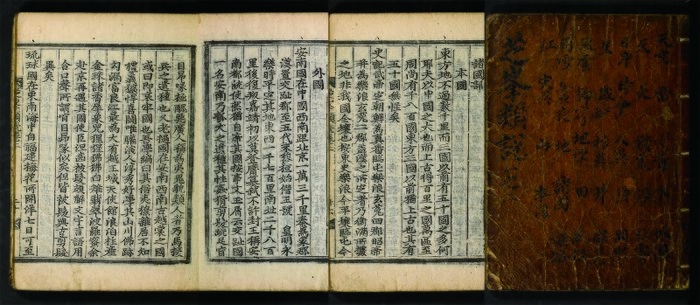 |
Title | |
| English | ||
| Chinese | 芝峯類說 | |
| Korean(RR) | 지봉유설(Jibongyuseol) | |
| Text Details | ||
| Genre | Literati Writings | |
| Type | ||
| Author(s) | 李睟光 | |
| Year | ||
| Source | ||
| Key Concepts | ||
| Translation Info | ||
| Translator(s) | Participants of 2018 Summer Hanmun Workshop (Advanced Translation Group) | |
| Editor(s) | ||
| Year | 2018 | |
Introduction
自賣 was a prevalent method for the impoverished commoners to obtain subsistence in the extreme situation of famine during the late Choson period. This was called 口活’
한성부 향도꾼은 동내 주민 중심의 인적 구성을 벗어나 이웃 동내, 나아가 한성부 전체를 지역적 기반으로 하는 대형 조직으로 변모하였다 했다. 또한 노비의 입계를 허락하지 않는 가문은 계원들 다수가 그 집에 쳐들어가 쌍욕을 해대는가 하면 그 집 처녀를 보쌈을 해와 형제들끼리 나누어 가질 정도였다. 이같은 무리한 행위에도 불구하도 계원의 세력이 너무나 강해 항의조차 못할 정도였다. 향도계 계원들의 숫자는 많은 경우 수 백명에 달했고 적은 계일지라도 100 여명에 이르렀다.
첫째, 그들의 상전 등 주위 양반들과 경제적 이해관계가 직접적이지 않았기 때문이었다. 주의 상전이나 양반들의 논밭을 경작하는 노비, 또는 하층민이라면 감히 토지소유주의 이해에 반하는 행위를 하지 못했을 것이다. 둘째, 익명성이 보장되고 회합이 용이한 도회지에서 활동했다는 점이다. 17세기 중엽 서울은 인구가 많을 뿐 아니라 유동 인구, 특히 도망 노비, 소작인들이 대거 이동함으로써 향도계원의 불법 혹은 도덕적 비난으로부터 일정부분 익명성을 보장받을 수 있었던 것이다.
connection with 중인.
